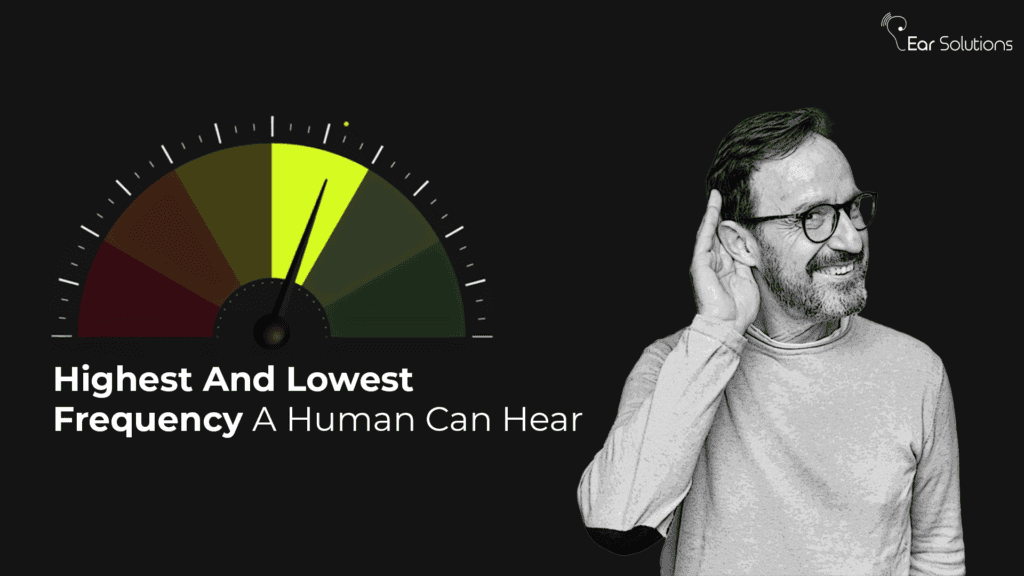Hearing is a vital sense that connects us to the world around us. Our ears enable us to experience a rich tapestry of sounds. One of the most fascinating aspects of hearing is the range of frequencies the human ear can detect. This range, however, has its limits. In this blog, we will delve into the highest and lowest frequencies that humans can hear, how these limits vary among individuals and the factors that can influence human hearing range.
Understanding Frequency and Sound
Sound is simply defined as a vibration that travels through the air (or another medium) as a wave. The frequency of these waves is measured in Hertz (Hz) and determines the pitch of the sound. A higher frequency matches to a higher pitch, while a lower frequency matches to a lower pitch. The human ear is capable of detecting a wide range of frequencies, but this ability is not unlimited.
What is The Lowest and Highest Frequency a Human Can Hear?
Lowest Frequency
The lowest frequency that a human ear can hear is 20 Hz. Sounds at 20 Hz frequency are extremely low-pitched and are referred to as “bass” sounds. These low-frequency sounds are not only heard but they can also be felt, as they can cause vibrations that connect through the body. Examples of low-frequency sounds are thunder, the rumble of distant traffic, and the deep notes of a pipe organ.Know More About: How Earplugs Offer Protection from Hearing Loss
Highest FrequencyAt the other end of the spectrum, the highest frequency that a typical human ear can hear is around 20,000 Hz or 20 kHz. These high-pitched sounds are often known as “treble.” However, as we age, our ability to hear high frequencies diminishes This condition is known as presbycusis. This is why older adults or senior citizens might have difficulty hearing high-pitched sounds.
Factors Influencing Human Hearing Range
There are several factors that can influence the range of frequencies an individual can hear:
Age: Ageing can significantly affect high-frequency hearing. Children and young adults typically have a wider hearing range than older adults.
Exposure to Loud Noises: Exposure to loud noises for a long time can damage the hair cells in the inner ear, leading to hearing loss. This type of hearing loss often affects the ability to hear high frequencies.
Genetics: Genetic factors can also play a role in determining an individual’s hearing range. Some people are naturally more sensitive to certain frequencies than others.
Health Conditions: Some health conditions, such as ear infections, otosclerosis, or Meniere’s disease, can impact hearing ability. These conditions might narrow the range of frequencies an individual can hear.
Environmental Factors: Continuous exposure to environments with high levels of low-frequency noise (such as industrial settings) can affect an individual’s sensitivity to these frequencies over time.
Testing Human Hearing Range
Hearing range can be tested using audiometry, where a person is exposed to sounds of varying frequencies and intensities through headphones. The results are plotted on an audiogram, which provides a visual representation of the person’s hearing threshold across different frequencies. You can get your hearing range tested at Ear Solutions. Our expert audiologist will perform the audiometry test and in case of any hearing issue, you will be provided with an appropriate hearing solution.
Practical Implications of Frequency Range
The range of frequencies we can hear has practical implications in various aspects of life, including:
Music: The enjoyment of music relies heavily on the ability to hear a wide range of frequencies. Musical instruments produce sounds across the frequency spectrum, and the richness of music is enhanced by our ability to hear both low and high notes.
Communication: Understanding speech involves hearing frequencies that range from about 250 Hz to 8,000 Hz. Clarity in this range is crucial for effective communication.
Safety: Many warning signals and alarms are designed to be within the human hearing range to ensure they are easily detectable.
Technology: Advances in technology, such as high-definition audio and hearing aids, aim to enhance our ability to perceive a broader range of frequencies, thereby improving the listening experience.
Conclusion
The human ear is an incredible organ capable of detecting a vast range of frequencies, from the deep rumble of thunder at 20 Hz to the high-pitched chirping of birds at 20,000 Hz. Understanding the limits of our hearing range and the factors that influence it can help us appreciate the complexities of sound and take better care of our auditory health. Whether through protecting our ears from loud noises, seeking treatment for hearing conditions, or utilising technology like hearing aids, we can ensure that we continue to enjoy the full spectrum of sounds that enrich our lives.





